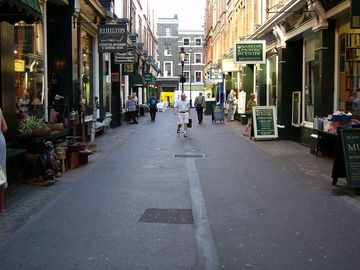

Take a look up – and you see how large the London Coliseum Theatre really is! It fills an entire quarter here, stretching from one main street to the next! The architect of the London Coliseum theatre was the top theatre architect of his day, Frank Matcham. On the request of Oswald Stoll, the variety-show magnate and the orderer of the building, he filled the interior decoration of the theatre with pseudo-Roman elements – just like the Coliseum in Rome. Either side of the stage there are huge racing chariots drawn by lions, and all of the decoration is based on Roman patterns. In its days as a variety theatre, the very best and most famous performers appeared here – including Vesta Tilley (the female singer who always dressed as a man), the clown “Little Titch”, and the surrealist comedian Max Wall. Even Laurel and Hardy appeared, during their European tour.
On the opposite side of St Martin's Lane we can see Cecil Court, a pleasant pedestrian street with a large number of antique bookshops. The land here was owned by Robert Cecil – the head of the Secret Police during the time of Queen Elizabeth I and then King James I, at the turn of the XVII century. Cecil was a ruthless man, but with great loyalty to the State. His most famous triumph was in catching the conspirators in the "Gunpowder Plot" of 1606, who planned to blow up Parliament. Cecil's men spied on the plotters, and were able to catch Guy Fawkes in the act of laying the explosives in the basement of the Parliament building. Britons still celebrate this act with fireworks on November 5th each year. The entire street is still owned by the Cecil family today. In 1764 the young Wolfgang Amadeus Mozart lived in a house in Cecil Court during his tour of Europe as an infant prodigy. The shop-owners in Cecil Court dispute the exact address where Mozart lived. The plaque can be seen at №9, above a shop owned by Tim Bryars. Others say that Mozart lived at №19. The Victorian shop-fronts in Cecil Court are often used as the setting for period films and television dramas.